
The 2009 Chelsea Flower Show
By Mike Chute
Just follow the crowd said the gentleman in Sloane Square when we got off the bus and asked for directions. Angie and I slipped easily into the stream of garden-goers marching briskly on the sidewalk, first turning right then left, heading unerringly towards the grounds of the Royal Hospital in Chelsea. The throng was festive and lively, even the weather was jolly – warm and sunny without a hint of rain, unusual for London in May. The crowd was an eclectic mix of men and women, young and old speaking English and other languages, but the one thing everyone had in common were tickets to the world’s most famous flower show. The Chelsea Flower Show (CFS) has been held each year since 1913 during the last week of May on the grounds of the Royal Hospital in Chelsea, London. It opens the London social season and is the premier venue for the annual introduction of new plant varieties. The show is sponsored by the Royal Horticultural Society and occupies eleven acres of the hospital grounds anchored in the middle by the Great Pavilion. This enormous structure itself covers three acres under one roof with booths, or “stands” as they are called, representing growers, nurseries and scientific displays of the latest advances in gardening. Rare plants from specialty nurseries and over 100 new varieties were introduced at Chelsea in 2009 and it is no exaggeration to say there were millions of blooms in the Great Pavilion. Outside, the Great Pavilion is ringed with display gardens – high profile exhibits featuring cutting edge English landscape design, another hallmark of Chelsea. These gardens compete for coveted CFS medals and can easily cost over £100,000 (about $150,000) and take three weeks to construct. Corporate sponsorship is essential to defray these costs and, unfortunately, many of the usual corporate donors chose to pass on this year’s show due to the steep downturn in the British economy. You couldn’t tell this by us, though, as the thirteen display gardens – half as many as last year – interpreting this year’s theme, “Garden as Art,” were impressive under any circumstances. Beyond the display gardens were hundreds of trade stands, where garden related tools and machinery were available for sale along with furniture, statuary, clothing, books, garden do-dads, and food galore. Amid all these stands was a smaller structure where all the floral arrangements were on display. My understanding was that the arrangements were spectacular but I will never know as the line – excuse me, the queue – was far too long for me t Nearby was a small but eye-catching display of clematis skillfully staged climbing towards the roof. I counted multiple plants of a dozen different varieties and knew there must be a hidden support but I couldn’t find it. I’m not crazy about clematis but I enjoyed this exhibit. Okay, the clematis were nice but I wanted to see roses. I spotted the David Austin stand and Angie and I started over. This year Austin’s Chelsea design was inspired by the Renaissance Garden at the nursery where beds of roses are planted on each side of a canal. Austin introduced several new varieties at Chelsea. His favorite, ‘The Wedgwood Rose’, a climber with translucent pale pink blooms and glossy foliage, commemorating Wedgwood’s 250th anniversary made its first public appearance. ‘Tam o’Shanter’, a large cerise-pink shrub celebrating the 250th anniversary of the birth of Robbie Burns was very well
Harkness Roses chose a more formal presentation with a series of large containers, each holding three dozen stems of a single variety, displayed in the round. Harkness also introduced several new varieties on Press Day: ‘Equity’, a red floribunda and ‘Girlguiding UK Centenary’, a red shrub, were among this year’s new roses. While I am an unabashed flower lover, the stand that I found most fascinating wasn’t flowers at all, but vegetables!
The Chelsea Flower Show had been on our travel wish list for some time and this year Angie and I built a trip to London around it. We had soaring expectations that Thursday morning as we walked through the London Gate, the main entry point to the show. Would it live up to its reputation? Indeed it did – the show was superb and I would recommend that all plant lovers include a pilgrimage to Chelsea on their life list of favorite places to visit. Tickets are only available in advance, selling out at £42 ($68) each well before opening day. The 2010 Chelsea Flower Show is scheduled for May 25 to 29. |
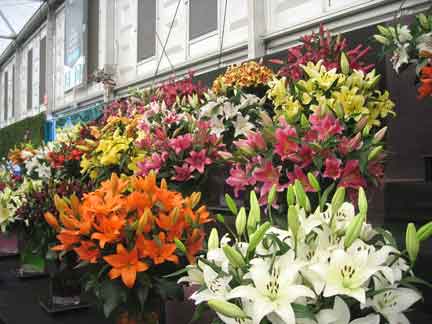 o stand in.
o stand in.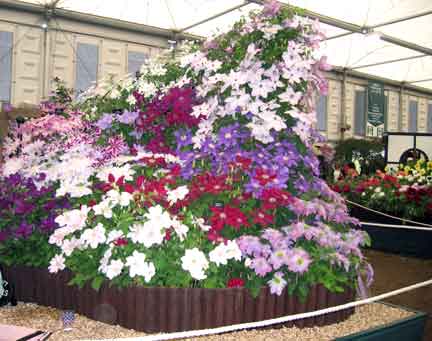 That was before we passed a tall arch full of strawberries, a new variety called “Chelsea Pensioner” that was being introduced at the show. The arch was a large form with many, many green pockets each holding one strawberry plant with cascading foliage and ripe fruit. This creative mass of strawberries was dazzling, the smell divine. Hmmm, vanilla ice cream right about then would have been divine, too.
That was before we passed a tall arch full of strawberries, a new variety called “Chelsea Pensioner” that was being introduced at the show. The arch was a large form with many, many green pockets each holding one strawberry plant with cascading foliage and ripe fruit. This creative mass of strawberries was dazzling, the smell divine. Hmmm, vanilla ice cream right about then would have been divine, too.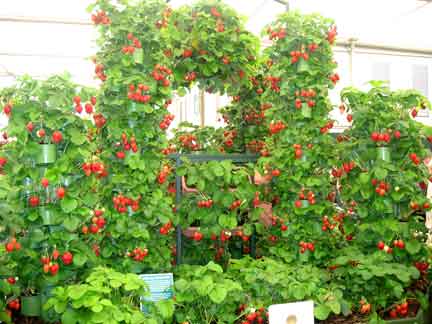 Enough of this, I said to myself, where are the roses?
Enough of this, I said to myself, where are the roses? 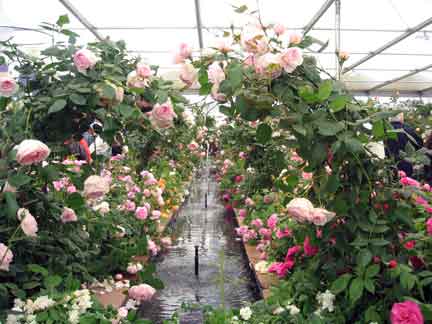 received and both varieties will be available in the United States next year. While there, we met Ann Saxby, a long time Austin employee and the person responsible for the Austin display. This delightful woman described all the challenges of planning, erecting and maintaining a large plant stand at a major flower show. She explained that since May is too early for roses to bloom in England, hundreds of bushes were forced in greenhouses at the nursery in Albrighton. The bushes were then packed in lorries along with statuary and other hardscape, the water feature, and lots of boxwood for the long ride to London. The results were dramatic. Four long rows of blooming English roses with the canal in the middle, water gently pumped through emitters adding a pleasant sound of falling water to the scene. Climbers were trained on pergolas and trellises establishing a vertical dimension to the stand and everything was surrounded by a seamless boxwood hedge resulting in a beautifully staged exhibit.
received and both varieties will be available in the United States next year. While there, we met Ann Saxby, a long time Austin employee and the person responsible for the Austin display. This delightful woman described all the challenges of planning, erecting and maintaining a large plant stand at a major flower show. She explained that since May is too early for roses to bloom in England, hundreds of bushes were forced in greenhouses at the nursery in Albrighton. The bushes were then packed in lorries along with statuary and other hardscape, the water feature, and lots of boxwood for the long ride to London. The results were dramatic. Four long rows of blooming English roses with the canal in the middle, water gently pumped through emitters adding a pleasant sound of falling water to the scene. Climbers were trained on pergolas and trellises establishing a vertical dimension to the stand and everything was surrounded by a seamless boxwood hedge resulting in a beautifully staged exhibit. 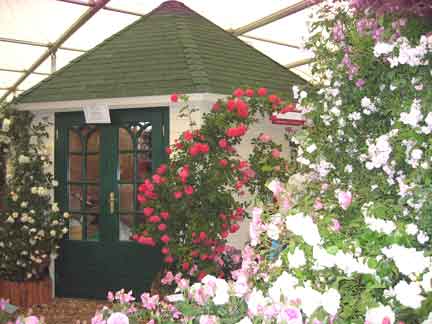 The 2009 Peter Beales Roses stand was completely different but no less striking, winning a CFS gold medal. The stand re-created an English summer house surrounded by a collection of modern and old garden roses. Beales rolled out three new varieties with a great deal of fanfare: ‘Highgrove’, a red, citrus-scented climber was introduced by Rod Stewart on Press Day followed by ‘Grosvenor House’ and ‘Weaver’s Way’,
The 2009 Peter Beales Roses stand was completely different but no less striking, winning a CFS gold medal. The stand re-created an English summer house surrounded by a collection of modern and old garden roses. Beales rolled out three new varieties with a great deal of fanfare: ‘Highgrove’, a red, citrus-scented climber was introduced by Rod Stewart on Press Day followed by ‘Grosvenor House’ and ‘Weaver’s Way’,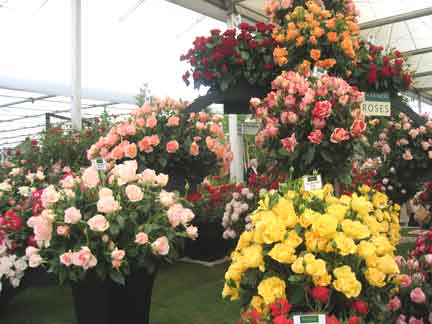 each hybrid teas. Both Queen Elizabeth and Prince Charles visited the Beales stand to congratulate him on his new roses and gold medal. We liked how the Beales stand created a sense of private intimacy in the middle of a busy flower show by surrounding the cozy little cottage with roses scrambling up and over arches looking like they had been growing there forever.
each hybrid teas. Both Queen Elizabeth and Prince Charles visited the Beales stand to congratulate him on his new roses and gold medal. We liked how the Beales stand created a sense of private intimacy in the middle of a busy flower show by surrounding the cozy little cottage with roses scrambling up and over arches looking like they had been growing there forever. 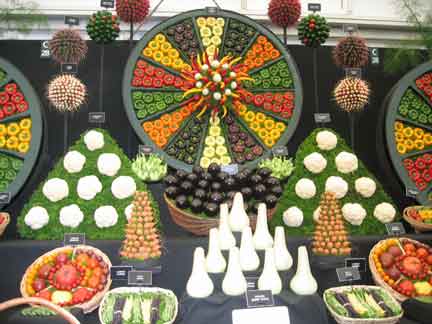 The Jersey Farmer’s Union, an agricultural co-op representing the Island of Jersey, the largest of the Channel Islands, staged a vegetarian wonder. The focal point was three large, old-fashioned spoked wheels standing upright with fourteen spaces between spokes on each wheel. Each space held ten perfectly placed peppers, each group of peppers a different color and the spaces in between peppers were patiently packed with parsley. Surrounding these wheels were round dishes of heirloom tomatoes of different colors and sizes artfully arranged to look like delicious fruit pies; triangles of creamy cauliflowers; pyramids of cherry tomatoes and baby carrots; baskets of eggplant stacked like cannon balls; large, strange looking onions standing upright like bowling pins; and a humongous bunch of the biggest leeks I have ever seen. The vegetables were grown as a co-operative effort from many of the farms on the 45 square mile island. Students in two schools were recruited to grow the carrots and inmates at the prison grew all the parsley. I kept returning to this stand all afternoon captivated by this remarkable and wonderfully colorful presentation of fresh produce as art. Chelsea, however, is not without its drawbacks and crowding continues to be a problem. Visitors from around the world flock to London on the last week of May to feast on the horticultural smorgasbord. In past years this international popularity led to intense overcrowding, especially in the afternoons. One measure to alleviate the congestion was extending the show dates from four days to five in 2005 and restricting attendance to 157,000 visitors for the five day show. We arrived on Thursday morning before 10 and found the first few hours to be comfortable but far more crowded after lunch.
The Jersey Farmer’s Union, an agricultural co-op representing the Island of Jersey, the largest of the Channel Islands, staged a vegetarian wonder. The focal point was three large, old-fashioned spoked wheels standing upright with fourteen spaces between spokes on each wheel. Each space held ten perfectly placed peppers, each group of peppers a different color and the spaces in between peppers were patiently packed with parsley. Surrounding these wheels were round dishes of heirloom tomatoes of different colors and sizes artfully arranged to look like delicious fruit pies; triangles of creamy cauliflowers; pyramids of cherry tomatoes and baby carrots; baskets of eggplant stacked like cannon balls; large, strange looking onions standing upright like bowling pins; and a humongous bunch of the biggest leeks I have ever seen. The vegetables were grown as a co-operative effort from many of the farms on the 45 square mile island. Students in two schools were recruited to grow the carrots and inmates at the prison grew all the parsley. I kept returning to this stand all afternoon captivated by this remarkable and wonderfully colorful presentation of fresh produce as art. Chelsea, however, is not without its drawbacks and crowding continues to be a problem. Visitors from around the world flock to London on the last week of May to feast on the horticultural smorgasbord. In past years this international popularity led to intense overcrowding, especially in the afternoons. One measure to alleviate the congestion was extending the show dates from four days to five in 2005 and restricting attendance to 157,000 visitors for the five day show. We arrived on Thursday morning before 10 and found the first few hours to be comfortable but far more crowded after lunch.